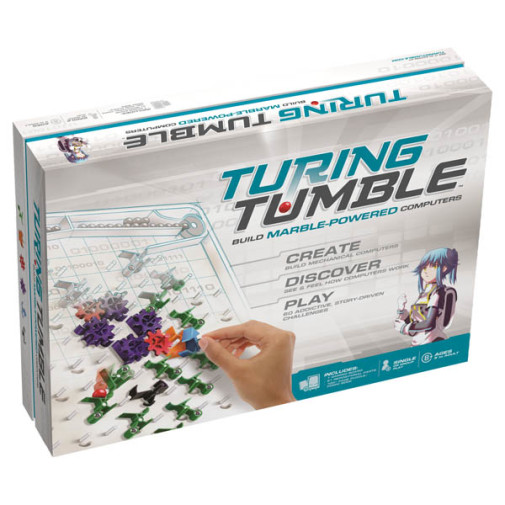We use cookies to make your experience better. To comply with the new e-Privacy directive, we need to ask for your consent to set the cookies. Learn more.
Turing Tumble: Gaming on a Mechanical Computer
If you've never heard of him, Alan Turing was the "father of modern computing" and played a pivotal role in developing machine computing as we know it. I think he would be proud to have his namesake attached to such a brilliant teaching tool! Part programming and part logic puzzle, the Turing Tumble begins as an unassuming peg-board with slots for falling marbles; think "Plinko machine." The goal is to turn the board into a simple computer using six marble-carrying analog equivalents of digital machinery: Ramps (direct balls down the board - circuits), Crossovers (change the direction of balls - also circuits), Bits (can be turned "left" or "right" - represent 0 or 1), Interceptors (prevent a marble from releasing more marbles - a "STOP" command), and Gears / Gear Bits (store information by being pointed "right" or "left" - a sort of register). When one marble reaches the bottom, it triggers either a Blue (left) or Red (right) marble to fall. The key to programming the Turing Tumble is controlling where these marbles end up!
To accomplish this, a 60-puzzle activity book accompanies the board. Each puzzle is styled & illustrated as part of a simple computer program that needs solved: an Objective ("Let exactly 9 blue balls reach the end. Intercept the 10th."), Required Output (a pattern of Blue and/or Red marbles), a Starting Setup (a clear picture of the parts which start on the board), and Available Parts (the parts you should use to accomplish the objective). The process begins with trial & error as kids figure out how each piece functions; but once they understand the correlation between "plastic pieces" and "programmable puzzle," it becomes all about logic!
Interwoven into the puzzle book is the story of a young space engineer who must escape an abandoned planet. Each puzzle brings her closer to rescue, seamlessly integrating the story and activity to help keep kids engaged. Perfect for learning logic, basic computing, and good, clean, screen-free fun! Includes 30 Ramps, 6 Crossovers, 10 Bits, 3 Interceptors, 4 Gears, 8 Gear Bits, 20 Red marbles, 20 Blue marbles, and 30 counterweights.
Turing Tumble is a new type of game where players (ages 8 to adult) build mechanical computers powered by marbles to solve logic puzzles.Use ramps, crossovers, bits, interceptors, gears, and gear bits to build marble-powered computers that can generate patterns, do logic, count, add, subtract, multiply, divide, and much, much more.
This is the standard Turing Tumble kit, which includes everything you'll need to start building computers:
Computer board
Computer stand
30 Ramps
10 Bits
8 Gear bits
6 Crossovers
4 Gears
3 Interceptors
1 Presser
Puzzle/comic book with 60 puzzles
20 Red marbles
20 Blue marbles
30 Counterweights
Discover how computers work!
| Product Format: | Other |
|---|---|
| Brand: | Upper Story |
| Grades: | 3-AD |
| EAN/UPC: | 868605000401 |
| Length in Inches: | 13.375 |
| Width in Inches: | 18.625 |
| Height in Inches: | 3.875 |
| Weight in Pounds: | 6.3 |

